Humans have measured things since the dawn of time, but they lacked the skills or tools in ancient times, so they used parts of their bodies as a gauge.
An inch was the length of an adult male’s thumb, a hand was exactly that, 5 outstretched fingers, and in the 12th century, a yard was the distance from King Henry I’s nose to his outstretched thumb.
But things changed with the invention of measuring tools. The oldest preserved measuring rod dates from circa 2,650 BC, and ivory rulers were commonly used around 1,500 BC.
We’ve advanced since then, and with the advent of digital technology, measuring devices have become super accurate, surpassing the capabilities of manual measuring tools. However, some people are still old school and rely on tried and trusted methods.
So, what are the different types of measuring tools? Let’s find out.
Distance
#1. Calipers

Calipers are one of the most common tools for measuring the dimensions of an object. They consist of 2 adjustable teeth that expand or retract to find your chosen objects width, length, or depth.
Typically, they are made of metal and can measure external and internal surfaces; plus, modern versions have digital displays that increase accuracy. Calipers are usually found in precision settings like machining, engineering, and other technical industries.
#2. Micrometer
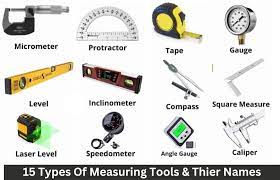
Micrometers are similar to calipers and are widely used in engineering and machine shops. They consist of a calibrated screw that adjusts to gauge the width, length, and depth of small objects.
Micrometers are highly accurate and have an error variation of 0.0001 inches. If you need a precision measuring tool, a micrometer is the right choice.
#3. Laser Measure
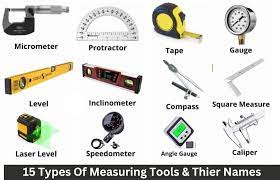
Laser measurers are highly accurate and typically gauge the distance between 2 objects. Real estate agents use laser measure tools to find the dimensions of rooms by judging the distance in length and width.
It works by firing a laser beam onto the solid surface of the opposing object and reading that distance. Most laser tools can measure distances of 30 feet, but some industrial versions can take this distance to 80 feet.
These tools are widely used in the construction industry and civil engineering because they are so accurate. However, like all electronic devices, laser measure tools need to be calibrated each day to ensure they give accurate readings.
Also, they don’t perform well on shiny surfaces or glass because the laser struggles to establish a connection with the surface.
#4. Ruler
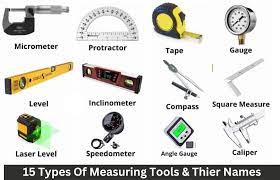
We’ve all seen a ruler, whether in school or everyday life. They are simple in concept and design and have been around for over a thousand years. Many early civilizations used rulers made from wood and ivory.
They come in various lengths, but the most common is the 12-inch ruler, with inches denoted along one edge and centimeters and millimeters along the other. Not only do rulers help you measure distances, but they also provide you with a straight edge to make accurate markings.
You can get wooden rulers, metal versions, and even foldable models that measure greater distances.
#5. Measuring Tape
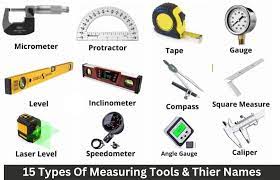
Tape measures are one of the most commonly owned and used tools in every walk of life. They come in 2 varieties: retractable tape measure and larger reel tape measures used in construction, engineering, and civil engineering.
The measuring tape has been around for a long time. It was invented in 1829 by Englishman James Chesterman, but the design of the first spring clip measuring tape was credited to American William Bangs in 1864.
Retractable tape measures are compact, easier for one person to use, thanks to their rigidity, and easy to transport. They are also inexpensive. In recent times, the laser measure tool has stolen much of the tape measure’s thunder, but as a tool they are still pretty hard to beat.
#6. Tailor’s Measuring Tape
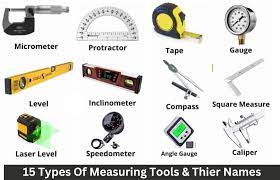
Tailor’s use a cloth tape that typically hangs around their neck. The reason why this tool is so useful is that when measuring and fitting garments, the human body is irregular in shape, and a rigid measurer wouldn’t work.
It allows the tailor to measure chests, waists, and leg circumferences to get accurate readings that can be translated into bespoke outfits that perfectly match their clients shape.
#7. Odometer
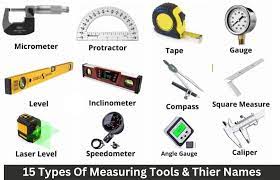
Odometers are used to measure the distance traveled by wheeled vehicles like cars, bicycles, and motorbikes. The device can be either electrical, mechanical, or a mixture of the two.
The odometer has a long and illustrious history. Englishman Thomas Savery first invented the odometer in 1698 for ships. Still, Benjamin Franklin, the first Postmaster General of the United States, built a prototype in 1775 and attached it to his carriage to calculate postal routes.
Even the Mormons invented a Roadometer to attach to their wagons to tell distance as they crossed the plains from Missouri to Utah in 1847.
The truth is, odometers have been around in one form or another since 27 BC when it is believed Archimedes invented one for calculating distance on wagons.
#8. Yard stick
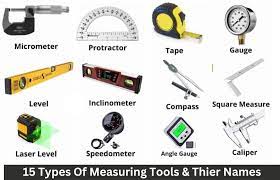
A yard stick is a measuring rod 36 inches in length, commonly referred to as a yard. It is a larger version of a ruler and is used in construction and civil engineering projects, as well as dressmaking and glass cutting.
#9. Meter Stick
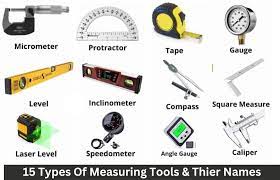
A meter stick does exactly what its name suggests. It measures distances in meter lengths. It is mainly used in construction and furniture making. They can be straight-edged or foldable to make them easier to transport.
#10. Wheel Measure
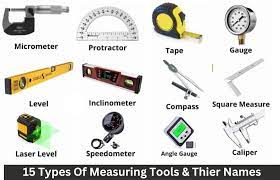
A wheel measure gauges the distance in either yards, meters, or half-rods. It works by counting the wheel revolutions on a mechanical counter, and the number of times the wheel turns dictates the distance.
It consists of a small wheel attached to a single handle with a counter device to record the number of times the wheel revolves.
These devices are used in construction, surveying, civil engineering and require minimal skill to master. They work better on smooth surfaces because you get better accuracy.
#11. Range Finder
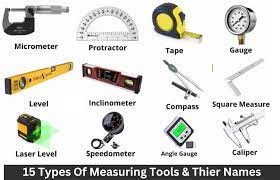
Range finders measure the distance between you and another object. They are specifically useful for gauging long distances. They either come as dedicated range finders or as a feature on a state-of-the-art-camera.
They have multiple uses from the military to get accurate targeting for weapons and even in golf, to measure the distance between shots. Hunters also use range finders to get an idea of the distance between them and their prey.
#12. Feeler Gauge
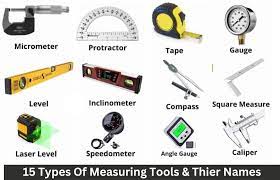
A feeler gauge consists of a series of ultra-thin blades to measure extremely narrow gaps and distances between parallel surfaces. They typically have between 20 and 30 blades in a set.
Industries like aerospace, automotive, gas and oil, and even the pharmaceutical sector use feeling gauges for accuracy. The HVAC and air conditioning industry also use feeling gauges to check the distance between sensors and ignition valves.
#13. Paint Thickness Gauge
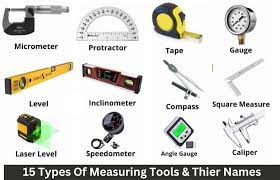
A paint thickness gauge is a digital tool that measures the depth of paintwork without damaging it in any way. The automotive industry uses this tool because car paint coatings are extremely thin, with only one side on display.
Dry film thickness is one of the most critical measurements in the coatings industry to gauge quality and cost.
#14. Altimeter
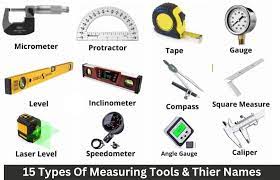
An altimeter is a tool that measures the distance between sea level and the altitude of an object. Planes use altimeters to determine their flying height.
This is crucial because, without a sightline reference, the perception of altitude diminishes, making it harder to tell actual height. When flying over mountains and cities, knowing the height of the aircraft avoids collisions and crashes.
It also tells you how close to the ground you are as you start the landing process. The measurement of altitude is called altimetry, and is directly related to bathymetry, which is the measurement of the oceans depths.
Angles
#15. Square
A square is an L-shaped or T-shaped instrument that measures 90-degree angles. They are used in construction, carpentry, furniture making, and any industry where accurate right-angles are crucial.
Not a lot of people know that the handle of a standard handsaw has a built-in square. Just turn the saw upside down and place the flat blade edge onto your material, sliding the handle, so it makes contact with the wood.
With the blade flat against the wood, you now have a perfectly straight line that you can mark with a carpenter’s pencil.
#16. Angle Gauge
Angle gauges find the angle of a fixed or worked object relative to a larger object. In forestry, they determine which trees are ready for harvesting within a given plot.
In woodworking, digital angle gauges with magnetic mounts attach to the saw blade to quickly find the right angle to cut the wood.
#17. Level
A level is a toolbox favorite with DIY enthusiasts and professionals alike, to ensure all lines and edges are perfectly straight and horizontal. They have bubble gauges to tell you whether you are straight and level.
There are many scenarios where a level will come in handy, from basic picture hanging and shelving to advanced carpentry.
Levels are the perfect tool for bricklaying, laying patios and driveways, and all manner of building and carpentry work. Finding the level is crucial to the accuracy of the project.
Without a level, it would be impossible to build anything perfectly upright and square.
#18. Protractor
A protractor is a flat semi-circle tool that measures angles in degrees from 0 to 180 degrees. Most of you will recognize this device from math lessons at high school when learning geometry, but a protractor has many more uses.
In the days before technology, protractors were commonly used to plot charts in naval shipping. The markings on a protractor consist of an outer layer of numbers ranging from 0 on the left side to 180 degrees on the right.
This arrangement is reversed on the inner markings, with 0 on the right and 180 on the left. You can buy double protractors that are entirely round, but most are semi-circular plastic devices that are inexpensive.
#19. Angle Protractor
An angle protractor is a combination of a protractor for the angles and a ruler for measurements and straight edges. It consists of a semi-circular tip with 0 to 180-degree markings running from left to right and a pivoting ruler.
#20. Bubble Inclinometer
A bubble inclinometer is used in physiotherapy, orthopedics, and rehabilitation to precisely measure the angles and inclines of joints. They also measure inclines and slopes and elevations/depressions of an object using gravity.
These devices are either electronic or mechanical in design. Also, you find a simplified form of a bubble inclinometer on your spirit level tool.
Quantity/Weight
#21. Pressure Gauge
A pressure gauge is a dial-based instrument that reads the pressure levels within a contained space like an air compressor or water tank. They are used in domestic settings on boilers and furnaces, as well as checking the pressure of car tires.
Pressure gauges are a vital safety instrument because if the pressure levels get too high, the likelihood of an explosion increases.
These devices are commonplace in almost every industry where heavy machinery is employed and heat, liquid, or gas is utilized in the manufacturing process.
#22. Measuring Cups
A measuring cup is a vessel primarily used in kitchens to measure ingredients for cooking. The most common ingredients the measuring cup holds are flour, water, and sugar. Measuring cups come as single items or as multiple kits with varying sizes.
#23. Thermometer
Thermometers measure the air temperature both indoors and out. They come in various styles, ranging from the most popular mercury thermometer with a long shaft and a bulb at the bottom that holds the mercury.
The temperature markings run along the channel where the mercury rises, thanks to the increasing air heat, and they are given as celsius and Fahrenheit. Most of the world measures their temperatures in celsius, but here in America, we prefer the good old imperial system.
Speed
#24. Speedometer
Unless you want to guess your speed and fall foul of the law, you’ll be glad that your car has a speedometer. It works by measuring instantaneous speed. Speedometers became popular in the early 20th century when motorcar ownership took off.
It became standard equipment in 1910, but it can trace its evolution as far back as 1888 when Giuseppe Bellussich patented his design and presented it to the world at the 1889 Paris exhibition.
The concept is a simple one: a magnet is attached to the driveshaft, and every time the wheel revolves, it makes a connection with a second magnet, known as a hall-effect, and it triggers the sensor to read the speed.
Other:
#25. Clock
We all know what a clock is and what it does. It is a device used to measure, verify, keep and indicate time. Humans have always estimated time, but before the invention of the sundial, they used the sun, moon, and lunar cycles.
The sundial was the first human-made time device. It works by a fixed dial with a triangular arm that casts a shadow on the dial when the sun shines. As the sun moves, so does the shadow on the sundial, telling the time.
It’s both simple and brilliant.
The word “clock” comes from the Latin “clogga,” which means “bell.” Clocks originated in the low countries of Europe, so the modern name derives from the Dutch/German “Klocke.”
Today, clocks come in mechanical and digital forms and cover a wide variety of uses, from watches, stopwatches, and for measuring longitude and latitude.
#26. Speed Square
The name “speed square” is trademarked by the Swanson Tool Company but is widely used as a generic name for this carpenter’s multitool.
It sometimes goes by the name triangle or rafter square, and it consists of a square, a protractor, a line scribing tool, as well as a saw guide to make accurate 45 and 90-degree cuts, and a common-width board ripping guide.
They can be made from aluminum, plastic, and steel, and are intended to speed up cutting wood accurately by finding the correct angles every time.
#27. Compass
We’ve all seen a standard compass in math at school, but they have many more uses than drawing exact circles on paper.
It consists of 2 points and an adjustable A-frame. You place the pin on a point on the map, extend it to a set distance and step the compass across the map to your endpoint, and that gives you an accurate distance to your destination.
In the early days of seafaring, ships used them to plot maps and charts. They were able to calculate the nautical miles of the journey then translate that into estimated journey time.
Knowing your journey time is useful in so many ways because it helps you calculate supplies like fresh food and dried goods, fuel, water, and other necessities. All that from such a tiny instrument!
#28. Glucometer
A glucometer is an electronic tool that measures blood sugar levels. It is sometimes called a glucose meter and is part of the arsenal of tools for those suffering from diabetes.
It is portable, compact, and easy to use as long as you aren’t squeamish. It works by firing a little spike into the tip of your finger. This draws a tiny droplet of blood, which you then press against a small plastic strip that inserts into the base of the glucometer.
Provided you have enough blood on the strip, it calculates your glucose levels and returns a number value. Most diabetics are looking for a reading between 6 and 8, but if it is higher, you may have poor control of your sugar levels.
Knowing this information enables people with diabetes to watch what they eat, check their sugar levels after eating and adjust their insulin intake to compensate accordingly.
Conclusion
Throughout history, humankind has sought knowledge. To do this, we need to understand the world around us, and to master these new skills, we have to measure distance, time, depth, height, and speed.
It’s always been about control. If we can measure, we can control. If we understand, we can rationalize. The discovery of new lands, oceans, flight, space travel, and even transforming our towns and cities, would not have been possible without thousands of years of measuring devices.
So, the next time you look at your watch, think of the aviators with their adapted watches with tachymeters to measure distance and speed.
The next time you pull out your compass to calculate geometry, think of those pioneers who navigated the globe using the same instrument.

